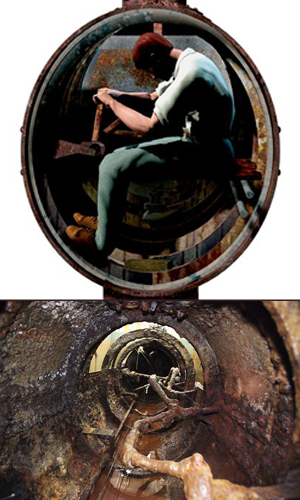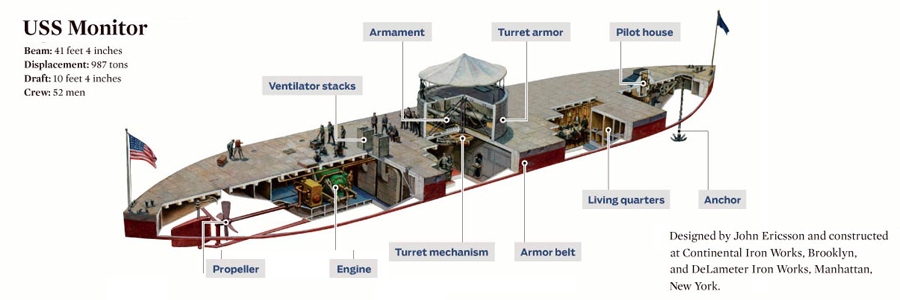
USS New Ironsides
She was a wooden-hulled broadside ironclad built for theUnited States Navy during the American Civil War. The ship spent most of her career blockading the Confederate ports of Charleston, South Carolina, and Wilmington, North Carolina, in 1863–65. The New Ironsides bombarded the fortifications defending Charleston in 1863 during the First and Second Battles of Charleston Harbor. At the end of 1864 and the beginning of 1865 she bombarded the defenses of Wilmington in the First and Second Battles of Fort Fisher.

USS Galena
Galena served on the James River Flotilla in September 1862 and assigned picket duty at Hampton Roads and Newport News, Virginia until 21 May 1863. Her ineffective iron plating — which had been badly damaged in the action at Drewry's Bluff from May 4 to May 15, 1863. She arrived at Philadelphia, Pennsylvania, and was decommissioned for repairs. Her iron plating was stripped off, and she was overhauled to operate as a wooden-hulled ship the rest of the war.

CSS H.L. Hunley
The CSS Hunley demonstrated both the advantages and the dangers of undersea warfare. It was the first combat submarine to sink an enemy warship USS Housatonic on Feb 17, 1864, although the Hunley was successful, it was lost at some point following attack. The Confederacy lost 21 crewmen and Hunley the inventor in three sinking's of the Hunley during her short career.
Use of the Ironclads In Civil War
Union Ironclads
The Union Navy performed three important functions during the Civil War in 1861, they had a three-point strategy to help win the Civil War. The first was to blockade the Confederate coastline, the second was to support the army in river operations, and the third was to counter Southern advances in technology, especially ironclad warships. The Union navy approached the new threat of ironclad warships by building vessels of three experimental classes. The first ship was the USS Galena (2). While representing an attempt at innovation, she was still a conservative design and proved to be not very successful. The second effort was the class that began with the USS Monitor (3). These ships were small, inexpensive, and quick to build. However, their high-risk design was viewed with some reservation by the Navy Department leadership. Therefore, for security, the US Navy contracted for a third design, which became the USS New Ironsides (4).
Confederate Ironclads
In order to survive, the Confederate Navy would need to borrow, build, buy, or capture a fleet, and they would have to do it quickly. The Confederacy assembled a fleet at each major port, including any small wooden vessels that could be bought, commandeered, or built, and large locally-built ironclads. These ragtag assemblages quickly earned the nickname "mosquito fleets" The CSS Virginia was ironclad converted from the captured USS Merrimack.
Led by the effective (but largely disliked) Stephen Mallory, the Confederate Navy Department was able to overcome its inherent deficiencies with some remarkable innovations, ideas that nearly turned the tide several times during the Civil War. The Confederates felt with ironclad vessels they could take on the Union navy and possibly open up the Union naval blockade. His new policy was based on four essential pillars: armored ships, rifled guns, commerce destroying, and submarine weapons. It is noted that it was in the areas of commerce raiding and submarine weapons that the South was largely (if only temporarily) able to negate the maritime superiority of the North.
Confederate River Defense Fleet
In 1861, the Confederate War Department had established a "River Defense Fleet" in New Orleans. The Confederates laid keels for six new ironclad gunboats and began converting an existing boat into a seventh (CSS Virginia). This imposing river force met with disaster in 1862. Two full-scale naval battles, one fought down river from New Orleans and the other upstream from Memphis, broke the back of Confederate naval power on the Mississippi. By December 1862 to July 1863, thirteen Union ironclads participated in the Vicksburg campaign. Rear Admiral Farragut's (1) Naval Forces working with Major General Grant's Army of Tennessee captured the city of Vicksburg, MS which in effect was like cutting the Confederate States in half. In August of 1864, there were one Confederate ironclad CSS Tennessee and only a handful of gunboats on the western rivers left to defend against 14 Union ironclads and other gunboats of Admiral Farragut in the battle of Mobile Bay, Alabama.
H. L. Hunley
One submarine of the Confederate States of America that played a small part in the American Civil War, but a large role in the history of naval warfare is the H.L Hunley. Hunley was designed for a crew of eight: seven to turn the hand-cranked propeller and one to steer and direct the boat. Each end was equipped with ballast tanks that could be flooded by valves or pumped dry by hand pumps. Extra ballast was added through the use of iron weights bolted to the underside of the hull. In the event the submarine needed additional buoyancy to rise in an emergency, the iron weight could be removed by unscrewing the heads of the bolts from inside the vessel. Its armenent was a spar torpedo, a copper cylinder containing 90 pounds (41 kilograms) of black powder attached to a 22-foot (6.7 m)-long wooden spar, as seen in illustrations of the submarine made at this time. The spar was mounted on Hunley's bow and was designed to be used when the submarine was some 6 feet (1.8 m) or more below the surface. The spar torpedo had a barbed point, and would be stuck in the target vessel's side by ramming. The spar torpedo as originally designed used a mechanical or electrical trigger attached to the attacking vessel by a cord, so that as the attacker backed away from her victim, the torpedo would explode.

Notes:
(1) - Admiral David Farragut is remembered for his famous order at the Battle of Mobile Bay, usually paraphrased: "Damn the torpedoes, full speed ahead!"
(2) - During the Battle of Drewry's Bluff, the USS Galena's armor, made up of relatively thin interlocking iron plates, had proved to be no match for Confederate heavy artillery. She sustained battle damage and was taking on water.
(3) - USS Monitor – She was the first commissioned ironclad of the Navy. She is most famous for her participation in the Battle of Hampton Roads on 9 March 1862, the first-ever battle fought between two ironclads. The Monitor fought the ironclad CSS Virginia of the Confederate States Navy. It was considered a draw but the USS monitor sustained more damaged.
(4) - USS New Ironsides was a wooden-hulled broadside ironclad built for the United States Navy during the American Civil War. The ship spent most of her career blockading the Confederate ports of Charleston, South Carolina, and Wilmington, North Carolina, in 1863–65. New Ironsides bombarded the fortifications defending Charleston in 1863 during the First and Second Battles of Charleston Harbor. At the end of 1864 and the beginning of 1865 she bombarded the defenses of Wilmington in the First and Second Battles of Fort Fisher.
(5) - CSS Tennessee the flagship of Admiral Franklin Buchanan, served gallantly in the Battle of Mobile Bay on August 5, 1864. On that morning with most of the Confederate's gunboats either sunk or dispersed Tennessee continued fighting until her steering was made inoperable. With two of her men killed, Admiral Buchanan and eight others wounded, and increasingly severe damage being inflicted on her, Tennessee was forced to surrender.

